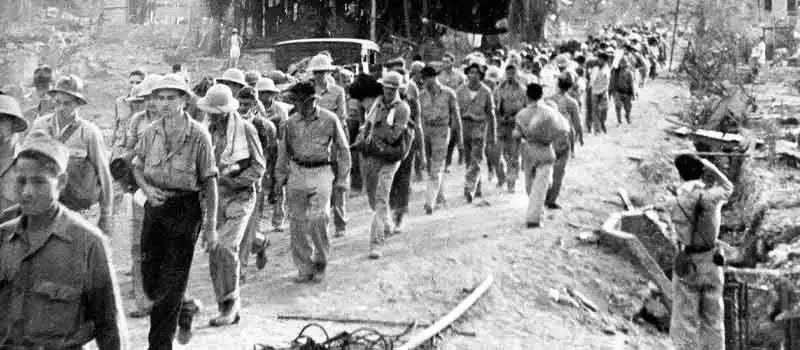- Military History
- Prisons, Prisoners & Camps
- Events
- The Bataan Death March (1942)

The Bataan Death March (1942) One of the most notorious atrocities committed against POWs in the Pacific theater of World War II
One of the most notorious atrocities committed against POWs in the Pacific theater of World War II, the Bataan Death March took American and Filipino troops to prison camps in the northern Philippines after they surrendered to the Japanese on the Bataan Peninsula on 9 April 1942. As a result of their three-month defense of the peninsula, American forces were already physically and mentally exhausted, having been forced to subsist on half rations or less and suffering from a variety of diseases, including malaria, scurvy, beriberi, and dysentery.
At the time of capitulation, the American commander, General Edward P. King, asked that he be allowed to organize the movement of troops out of the peninsula, but the Japanese refused, having developed their own two-phase plan. Under their program, captives would first be assembled at Balanga, a town about halfway up Bataan on a main road near the east coast. The bulk of American troops were located in the area of Mariveles on the southern tip of the peninsula and moved up the main highway, which ran east, then north along the coast.
A smaller number marched up a secondary road near the west coast and then crossed eastward to the assembly point. Since the defenders were scattered at the time of surrender, some traveled only a few miles, but many walked 20 miles (32 km) or more to get to Balanga. After this first phase was completed, a second phase began, with the captives moving north along the east coast highway to its intersection with Route 7, where their path turned east to the railhead at San Fernando, a trek of about 31 miles (50 km). From San Fernando they rode 25 miles (40 km) by train to Capas, then hiked another nine miles (15 km) overland to Camp O'Donnell, a former Filipino army base in central Luzon and their final destination.
They were to be fed periodically along the way and rested at established intervals. Those needing medical services were to be treated at field hospitals set up in Balanga and San Fernando. Both parts of the plan quickly unraveled. Lieutenant General Masaharu Homma, the overall Japanese commander, left its execution up to two subordinates, who failed to coordinate their efforts. Many other problems developed as well. The plan estimated that 35,000 prisoners would be taken, but twice that number surrendered (12,000 Americans and 66,000 Filipinos).
Nor did the Japanese appreciate the malnourished and dispirited condition of their captives. Supplies that were to be used for the prisoners were used instead to support the Japanese attack on Corregidor, which began at the same time as the evacuation. During that attack, some POWs were killed by friendly fire at Mariveles when the removal began. Many who died along the way succumbed to exhaustion (their guards expected them to march much faster than they could), exposure, disease, hunger, and thirst. A portion of the suffering was the result of thoughtlessness, but Japanese cruelty also took its toll as men were beaten, robbed, bayoneted, shot, beheaded, run over, mutilated, and even buried alive.
One incident of mass murder occurred near Balanga when Japanese soldiers executed 350 to 400 men of the Ninety-first Philippine Army Division. The train trip from San Fernando to Capas was a different kind of hell for the prisoners as they were crammed into metal railroad cars whose doors were then sealed. The stench of dying men and the heat generated by the metal cars made the journey unbearably oppressive. However, Japanese treatment was inconsistent; some prisoners rode in trucks to Camp O'Donnell while their compatriots suffered bitterly along the march.
In total, between 600 and 650 Americans and 5,000 to 10,000 Filipinos perished in the Death March, which ended in late April.
American officials did not learn of the fate of their men until mid-1943 and waited until early 1944 before informing the American public. Demands for retribution were swift, and when President Harry S. Truman explained the use of the atomic bombs on Hiroshima and Nagasaki in August 1945, he mentioned the atrocities at Bataan. After the war, General Masaharu Homma was tried by the International Military Tribunal of the Far East for war crimes committed by his men, and he was executed in 1946.
- Japan
- Philippines (since 1898)
- United States
- WWII (1939-1945)
- Pacific War (1941-1945)
- {{#owner}}
- {{#url}} {{#avatarSrc}}
{{name}} {{/url}} {{^url}} {{#avatar}} {{& avatar}} {{/avatar}} {{name}} {{/url}} - {{/owner}} {{#created}}
- {{created}} {{/created}}























